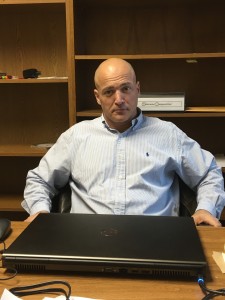

Steven Carpenter, assistant professor of animation at Drury University, is a computer artist who has 20 years of production experience in both film and television.
He has also taught computer animation for 13 years has worked on projects such as “Star Trek: Deep Space Nine,” “Star Trek: Voyager,” “Xena: Warrior Princess,” and “Dungeons and Dragons.” For his work on “Children of Dune,” he won a Primetime Emmy Award for Outstanding Special Visual Effects for a Miniseries, Movie or Special in 2003.
Animation is similar to cartoons and comics. A cartoonist could develop characters and have the artist draw the character in any way or situation he or she wanted.
Creating such a world was a big part of the philosophy of Chuck Jones, the creator of the Looney Tunes. His idea of storytelling was to create interesting characters, like Bugs Bunny, and then drop them into a situation and see how they would react, like the episode “Invasion of the Bunny Snatchers.”
What exactly is animation?
The root word for animation actually mean “to give life.” And so, that’s what we’re doing. We’re giving life to inanimate objects. So, obviously, I definitely make a decision between creature animation and character animation. Creature animation is, you know, a monster, where they just roar and destroys. Whereas, character animation — then the character has emotions, and has character flaws and has likes and dislikes. So, you know, you try to in view your character with a bunch of personality traits and the go from there.
How exactly did animation come to be?
Animation got its start, obviously very early on, when film was first introduced. And the first animators were illustrators. So they were kind of like the rock star of their day. And then, this was obviously way before compositing and sound effects and film effects, stuff like that. Earlier illustrators, the big being Winsor McCay. He is pretty much being credited as the grandfather of animation. So, when film came out, all it is is a series of pictures, back to back. There is something call persistence of vision, and so your brain sees a series of images and if they are connected, it will kind of fill in the blanks.
How did animation get big among the general public? When exactly did that get really big?
There is definitely, at some point, you have to talk about (Walt) Disney. There were several animators before Disney, but Disney, what he was really good at is taking the technology to the next level. Even though Disney was an animator himself, he was definitely more of the big-picture guy. He would hire talented animators, so there’s the nine old men, as far as Disney goes. And they are the one who developed the 12 principles of animation, which were standard things, like anticipation, overlapping action, waiting, timing, and things like that. So it was early ’30s, early ’40s.
How did Disney change the way animation was made with “Snow White”?
What people don’t realize if that Disney invented a lot of things and processes, as afar as animation goes. So he had like this one multiplane camera, that basically that was a bunch of clear glass, and one every piece of glass had a different kind of element. He had several planes of glass, that he could light each plane somewhat differently than the others, to get a depth of feel. Even though it’s a flat image, it had a lot of depth to it. The nine old men developed this process that Pixar has kind of picked up on it. What Disney would do is that they would do test featurettes to work things out and resolve all the issues. They knew they wanted to do “Snow White,” so what technically issues are we going to have that we have to resolve. They had already mastered what they needed to know.
How has the art of animation change over the past century? Because, back when Disney stared, it was all hand drawn, and now, it is more CGI animation.
It is a good 20 years between Winsor McCay and Disney. McCay was ahead of his time, so there was a peak with him and a peak with Disney. And obviously, CG has got so much better. When it first came out, it wasn’t very good, and wasn’t used for much character work, but it did industrial things very well. If you go back and look at Pixar Films, Pixar understood that they weren’t ready to do human characters. So their first film was “Toy Story,” which had very few human characters. Pixar stayed away from human characters early on. As they progress, they were resolving different things, and becoming better acquainted with human characters, resulting in “The Incredibles.”